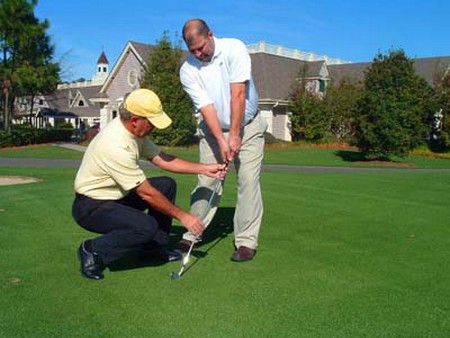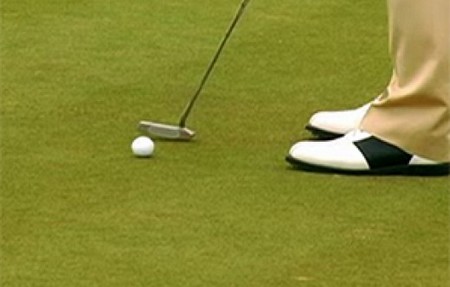One of the worst putting problems is the yips, where the putter literally seems to have a mind of its own, particularly on short putts. This is more likely to happen as one gets older. It can be a problem with the very shortest of putts. The wrists should stay firm with short putting. If you ‘yip’ putts or your short putting stroke becomes rusty, a change of grip can help.
Cross-handed putting
In a cross-handed putting stroke the left arm is extended down the putter, ideally with the left index finger pointing down the shaft. The right hand is at the top and the left beneath. By setting the grip in this way, the back of the left wrist is immediately much straighter and firmer at address.
It can also make the shoulders less dominant, with the right hand and right shoulder less likely to take over. If your short putting stroke is poor, particularly with the clubface twisting through impact, try this grip. Most players who use it move to a conventional grip at around six to eight paces.
If your short putting stroke is poor, make sure you hold the putter firmly enough. Grip the club reasonably firmly and make sure the club hangs slightly above the ground at address. If you hold it too loosely, then the first movement tends to be to gather the weight of the putter and that can set off a jerky stroke. Hanging the putter makes it easier to make a slow, firm stroke.
If you are a poor short putter, remember that one of the problems is that you feel embarrassed about missing. Never feel silly about missing a short putt. After all, even professionals frequently miss them. If playing with strangers, tell them not to be shocked if you miss the odd short one!
Practice swings – yes or no?
A practice swing with a short putt can often confuse your aiming. Never make a practice swing from beside your ball straight towards the hole. When you then step forwards to address the ball the tendency is to aim away to the right. Any practice swing must always be parallel to your putt. Alternatively, if you are taking a practice swing just to calm your nerves, do it in a completely different direction. If the practice swing is to give you the feeling of direction – remembering that that is the most important part of short putting – then do it behind the ball or ahead of the ball.
Remember that if you do it between the ball and the hole, you shouldn’t touch the ground. Make sure your practice swing doesn’t confuse your aiming. If you don’t aim correctly then try short putting without any practice swing. It may be causing the aiming difficulties.
Routine
There are three ways to approach a short putt. Firstly, do one or two practice swings. (Don’t do more if you get nervous.) Then let go of the putter with one hand, set it behind the ball, re-grip and play your putt.
The second alternative is to do your one or two practice swings, keep hold of the putter, set it to the ball and then play your putt. (Some players find that they can’t do this when they get nervous.)
Or thirdly, don’t do a practice swing at all. The first routine is probably the most common amongst professional goiters. However, most importantly, if you do a practice swing, always make sure it is parallel to your target.
Categories
Advertisements
Recent Articles
 How to Understand Bed Sizes – A Small Guide
How to Understand Bed Sizes – A Small Guide How to Select Some Must Have Kitchen Accessories
How to Select Some Must Have Kitchen Accessories Best Way to Change a Car Tire
Best Way to Change a Car Tire Best Way to Write an Affirmation
Best Way to Write an Affirmation Best Way to Take Charge of Your Financial Life
Best Way to Take Charge of Your Financial Life Best Way to Survive a Party When You Don’t Know Anyone
Best Way to Survive a Party When You Don’t Know Anyone Best Way to Stop Self Sabotaging Yourself
Best Way to Stop Self Sabotaging Yourself Best Way to Start Journal Writing
Best Way to Start Journal Writing Best Way to Speak with a Powerful Voice
Best Way to Speak with a Powerful Voice Best Way to Simplify Your Life
Best Way to Simplify Your Life Best Way to Respond to a Put-Down
Best Way to Respond to a Put-Down Best Way to Reduce Acne Breakouts
Best Way to Reduce Acne Breakouts Best Way to Recover from Dining Disasters
Best Way to Recover from Dining Disasters Best Way to Quit Your Job Gracefully
Best Way to Quit Your Job Gracefully Best Way to Make Your Own Website
Best Way to Make Your Own Website



Leave a Reply